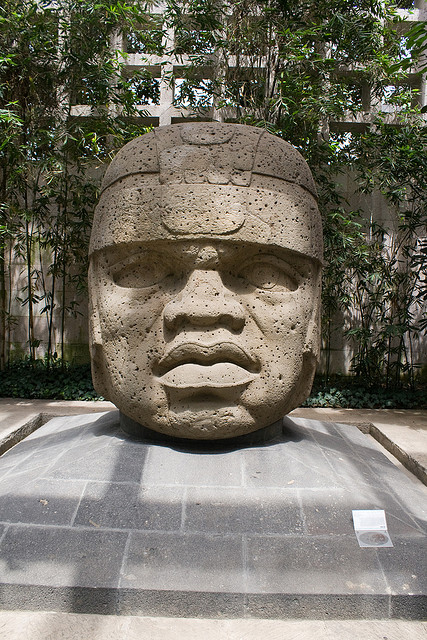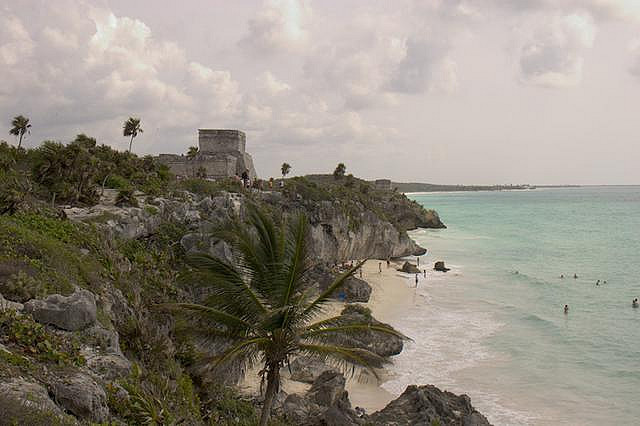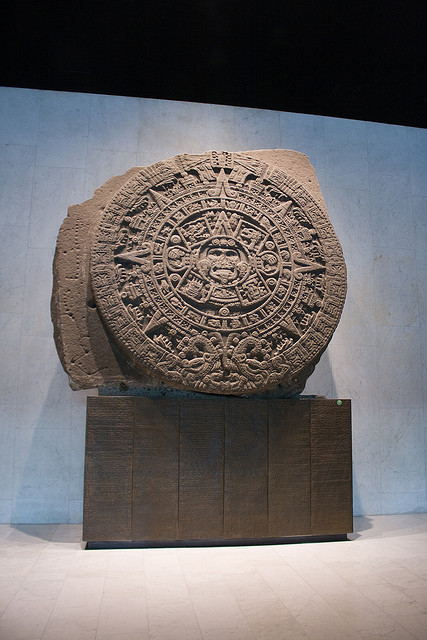It’s become more and more widely known that, before first contact with Europe, the Americas were populated by advanced civilizations with complex systems of writing, government, and technological innovation. A number of these civilizations were clustered in the area known as Mesoamerica, which presented geographic difficulties for its inhabitants due to its harsh climate and environment, and yielding few natural resources. So, how did Mesoamerican civilizations thrive?
Guest Ann Twinam from UT’s Department of History discusses three of the major Mesoamerican civilizations: the Olmec, Maya, and Aztec (Mexica), and their once-forgotten contributions to human civilization.
Guests
 Ann TwinamProfessor of History, University of Texas at Austin
Ann TwinamProfessor of History, University of Texas at Austin
Hosts
 Joan NeubergerProfessor of History, University of Texas at Austin
Joan NeubergerProfessor of History, University of Texas at Austin
Let’s just start with a definition: what is Mesoamerica?
I think, broadly, we can define Mesoamerica as an area that includes Mexico and Central America. In that area, when we talk about pre-contact civilizations, we’re talking about the Olmec, the Maya, and the Aztec (as three of the major civilizations; there are many others).
And when you say pre-contact, you mean before the Europeans arrived to the new world.
That’s right. I like to say that better than conquest.
Good. Let’s start with the lay of the land. What are some of the key characteristics of geography, what kind of natural resources, and how did they shape Mesoamerica for the centuries before Europeans arrived?
I think that’s a great question. I think the first thing that you need to do is imagine the topography. One way is to think of Mexico and Mesoamerica is to imagine it as a 3D pyramid and then chop it off horizontally, about halfway down, and then look at it from the side. That’s kind of what Mexico looks like. In the center, we have this high plateau, with mountains that are running north and south, and then the sides of Mexico and Central America sort of slope downward to the sea level areas, including the ports of Veracruz on the Caribbean and Acapulco in the Pacific.
And why is the topography important? Has it had a historical impact?
The topography is critical because it meant that there were different resources in the highlands than on the coast. There were areas for trade and it brought about conquest as well. The central area, the high area, produced obsidian, which is really critical. It’s a black volcanic stone and it’s as sharp as surgical steel—so it was clearly an important trade artifact. And the lowlands produced seashells and feathers from tropical birds, and these were considered to be very valuable for rituals. Also, the topography is important because the mountains on that central plateau are running north and south. What that meant was that there was an easy corridor for tribes migrating southward. And the history of Mesoamerica is really the history of people on the move, as people are moving from north to south.
Another key characteristic, unlike what we’re familiar with in North America or the US, is the absence of navigable rivers. So it’s very difficult to move goods from one place to another. And this was made even harder because there were really no animal resources in Mesoamerica. There were no large domesticated animals. There were no beasts of burden. If you moved something in Mesoamerica, it moved either on the backs of men or in canoes if you were situated on a lake.

Let’s turn to talk about the people. What are the key groups of people or key civilizations of Mesoamerica?
There are many, but the three that I thought I’d talk about were the Olmec, the Maya, and the Aztecs. We can look at those in chronological order. One of the earliest Mesoamerican people were the Olmecs who arose during what we call the formative period, from about 1500 BCE to 400 BCE, and they established settlements both in the Mexican highlands and along the coast. And they’re really important — they’re called the Mother Culture of the Americas. They’re associated with a number of characteristics that then later passed on to other Mesoamerican civilizations such as the Maya and the Aztec. These included a lot of things: one was monumental sculpture. The Olmecs are known for their huge carved heads. These were six to fifteen feet high, they weighed tons, and they were very characteristic. They had slanted eyes, sort of squished noses, and flattened lips. If you see one, you know it’s Olmec.
They’re also known for their ceremonial complexes. The Olmecs were the first to build central places for worship with defined avenues. Another thing the Olmecs were known for was constructing some of the first pyramids. Later civilizations also had pyramids, although they looked somewhat different from the Olmec, who were the first.
They were also the first in sports. The Olmecs were the ones who started, or are associated with starting, the complex ball game that Mesoamerican peoples played. You would try to put a rubber ball through high hoops. These civilizations created ball courts for people to sit and watch these games. The first of these ceremonial complexes appears in the Olmecs.
The other thing the Olmecs did was count really well. We used to think it was the Maya, who lived centuries later, who invented the calendar, but now we know it originated with the Olmecs. They invented two calendars, the solar calendar of 365 days and the lunar one of 260 days. And every 52 years, the first day of a lunar and solar calendar coincided. This is critical because Mesoamerican peoples think in 52-year chunks, just as we think in decades or centuries, they think in fifty-two year chunks. So it was, we think, the Olmecs who begin to think about the fifty-two year chunk thinking, which also becomes very important later on for the Maya and even as important for the Aztecs. So this was another thing that they pioneered.
We used to think—the poor Maya are getting dissed here a bit—that the Maya developed writing, but now we know that it began with the Olmec too. These are important reasons, given their architecture, and their ball courts, and the calendar, why they are the Mother Culture of the Americas.
So did the Olmec civilization simply disappear? Did it merge into later cultures? What happened?
Well, when we don’t know. Weknow a series of things that might of happened: peoples revolting, environmental reasons, in this case there might have been a volcanic eruption, there could have been climate change. It’s one of those mysteries we still haven’t solved.
Let’s turn then to talk about the second great group, the Maya. When did they become important, or when did they appear in Mesoamerica?
The Maya appeared around 0 BCE, and they were a pre-contact civilization, which is important, through 800, but unlike the Olmecs, the Maya continue to exist today. In modern Guatemala, in Mexico, in Yucatan, in Belize, and Honduras there are still people who descended from the Maya and who still speak Maya dialects.

And were they similar to the Olmecs? You talked about things that we thought were originated by the Maya, but were in fact older.
Yes. As I said, the Olmecs are the Mother Culture, but then later civilizations, like the Maya, also picked up some of these characteristic things. For example, just like the Olmec (perhaps even more impressive than the Olmec), the Maya built ceremonial centers. These are now, of course, important tourist sites like Uxmal and Chichen Itza and Tikal. However, the Maya pyramids are very distinctive from other Mesoamerican pyramids because they’re really steep and really narrow. But the Maya also had the same ball courts or had ball courts like the Olmec and they also used the same version of the Mesoamerican calendar. They too had this view of time and divided their chronology into these fifty-two year cycles. They innovated though in that they developed a way of counting back. So they counted each individual fifty-two year cycle as it went back. This is something called the long count, which made it possible for them to count back thousands of years in their history. And, of course it was these kinds of cycles and counting that we associated a few years ago with false worry that the Maya calendar predicted that the world was going to end in 2012. It was part of these cyclical counts that that idea arose.
So what happened was, after the classic Maya civilization collapsed around 900, although the Maya themselves didn’t disappear, they largely abandoned many of their ceremonial centers. And so when the Spanish arrived in the early 16c, although many of these centers still existed, the Maya themselves couldn’t read the writings on their codices, or the inscriptions that were carved throughout the temples or on their obelisks. Their history was effectively lost. As time went on, many of their centers were covered with jungle and trees. They were only discovered by explorers such as John Stevens in the early 19c. Or, more recently, infrared satellites have been used to try to locate Maya ruins. The first interpretations were essentially that they were the intellectuals of the Americas — and remember we gave them all these accomplishments, like writing and the calendar and all these things, which we now know they didn’t pioneer. But it was clear that they had a sophisticated form of writing. The theory developed that they were this peaceful, intellectual civilization with a particular interest in mathematics and astronomy. So one of the great challenges of the 20c, and actually still ongoing, was to try to decipher the Maya script and to find more about this civilization in their own words.
How has learning to read their texts changed what we know about them? What do we know about them now that we didn’t know before?
Well their lists told us everything. They told us their histories. We now know who their leaders were, we know about their wars, we know more about their religion. We know that, far from being the peaceful stargazers we thought, we now know they engaged in constant combat. Nor was their religion non-bloody or ethereal. They forwarded and continued this Mesoamerican propensity for offering blood as a gift for the gods—especially the Mayan nobles, both men and women. We have pictures of these; we see them now in paintings of them doing this. They were expected to offer blood to the gods. The women often put spines through their tongues and blood would come and they would sacrifice the blood. Men had some instruments that allowed them to prick even more sensitive reproductive parts. You could look at those pictures as well. The Maya were not as peaceful or otherworldly as we previously thought. But they really pale compared to the more current understandings of the Mexica, or as we call them more commonly, the Aztecs.
So then when did the Aztecs appear, and how did they fit into this picture of civilizations in Mesoamerica?
The Aztecs are really part of this whole Mesoamerican theme—the theme of migration that I talked about, of migrating peoples, moving from north to south. We have in the Aztec codices, their history as they engaged in this migration. We know they moved down into the central valley and what was a lake system, which is now around Mexico City, around the 1320s. And this area was already settled by numerous other city-states. In the early years, the Aztecs were subordinate to these other city-states. Eventually they founded their capitol, Tenochtitlan, which was located on an island in the lake system. The center of Tenochtitlan is now modern Mexico City. Like the Olmecs and the Maya, the Aztecs built pyramids, ball courts, they had ceremonial centers, and they also used the fifty-two year calendar.

How were they different from the earlier peoples?
The Aztecs really were the most successful expansionists in the pre-contact period. They conquered from the Pacific coast to the Caribbean. They were demanding tribute from conquered populations. This of course is related to this idea that, as populations grew, and this was an environment where it was resource-scarce, the conquered civilizations would try to get food and other kinds of tribute flowing into the center to get their own population to grow. Conquest became an important part of Aztec history.
Of course what’s most well known about the Aztecs is that conquest went along with their practice of bloodletting. They carried it to the Mesoamerican extreme, transferring this to tens of thousands of people who were killed through human sacrifice. To understand why this happened: it’s a pretty gory thing to think the Aztecs were so involved in human sacrifice that sometimes tens of thousands of people could be killed as in one case, at the dedication of the great temple at Tenochtitlan. But you have to understand it from the Aztec perspective, from the Aztec religion or their view of where they were in the world. And sort of critical to this was their creation myth. The Aztecs believed the world had been created and destroyed four times before they had lived. They believed they lived in the fifth world that had been created; they called it a sun. At the start of the fifth sun, according to their legends, the world was in darkness so the gods met to create the world. They asked one god to throw himself in the fire and let the world begin, but the god chickened out. So then they asked another god, and he was a lesser god, and so he finally threw himself into the fire so that the world might be created. Then the first god was ashamed so he jumped into the fire as well. Then the story goes that the gods waited around the fire for the sun and the moon to rise, and when they didn’t, they asked why the two gods hadn’t turned themselves into the sun and the moon and created the new world. The gods said they were waiting for sacrifice. So as the legend goes, one by one the gods threw themselves into the fire and as they did so the sun and the moon began to rise and the world was created again. And this established the fundamental idea that sacrifice to the gods was essential to keep the world going; first sacrifice of gods themselves and then later human sacrifice.
These were quite large-scale sacrifices. Who were the victims? What did they think of this? Where do they come from?
The victims came from various different groups. Many of them were warriors. When the Aztecs fought other city-states to demand tribute, they would fight to capture, not to kill. They would bring the victim back and he would be sacrificed on the pyramid. His body would then be thrown down the pyramid and his captor would engage in ritual cannibalism. This was a mutual kind of thing because if soldiers from Tenochtitlan were captured, they would also find themselves led up the pyramid of another city-state to be sacrificed. This was a very common practice in the Aztec areas of conquest.
And there were many who really believed in this. For example there was a famous warrior who taken captive and he was such a good soldier they agreed not to sacrifice him if he would fight for them. He agreed to do that for many years, but then he returned and asked to be sacrificed. There were other people sacrificed as well. Women were not taken up to the top of the pyramid. The Aztec sacrifice was particularly gory. They would use obsidian knives to cut out the living hearts of their victims and then offer the blood to gods. Women were not led up the pyramid that way. They usually did a dance at the bottom of the pyramid and then they would be beheaded. There were some particularly gory ceremonies where crying children were sacrificed to Tlaloc, who was the rain-god. When children cried it was assumed that was good.
Is there any sense in which the mass sacrifice of the population was connected with some kind of population control?
There have been a number of theories about that, but when you think about it, it doesn’t really make sense. If you really want to control population, you want to control the women who are producing young children. What you’re doing is sacrificing the warriors, who when they come back, are agriculturalists. So actually no, it didn’t make a demographic sense to sacrifice mostly men. You’re also sacrificing not your own people. You’re sacrificing people from the periphery.
So then what happens to the Aztecs? Do they die out before the Europeans come? Are they there?
Oh no, the Aztecs are fully there when the Europeans arrive. Tenochtitlan is a wonder. It is described in amazing detail by the conquistadors. Cortez was very lucky to be able to conquer Tenochtitlan. Some Spaniard would have done it eventually, given the technology that the Europeans had: the ability to move a lot of people across the Atlantic, the use of steel, horses. There were many advantages Europeans had, but that first band of conquistadors had to win every single battle. This again goes back to the human sacrifice. They had a lot Indian allies, allies on the coast, because what Cortez did was pick up many Indian groups who rejected the Aztecs, because they didn’t want to send people for human sacrifice. They saw the Spaniards as someone to ally with. So by the time Cortez arrives at Tenochtitlan, he has an army of thousands and thousands of Indian warriors as well as Spaniards.
OK, I have one final question. Is Quidditch the modern day version of the basketball game of Mesoamerica?
It’s close! It’s pretty close.
It looks very similar to what you’re describing.
It is. Except I think the balls are better in Quidditch.